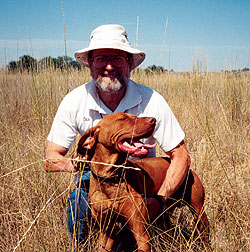By James B. Spencer
 Dick Calhoun |
"I use formal force-fetch training," Dick said, "to teach reliable retrieving to pointing breed dogs that don't retrieve naturally. I also use it to cure two difficult mouth problems, hardmouth and sloppy-mouth.
"A hardmouthed dog damages the birds he retrieves. A sloppy-mouthed dog drops and picks up birds repeatedly instead of bringing them straight in as he should. I see no need for force-fetching a dog that retrieves well naturally and doesn't have either of these mouth problems."
In force-fetching a dog, Dick teaches it to hold, carry, and pick up a bird on the command "Fetch," and to release it, that is, deliver it to hand, on the command "Give." He starts out using a small plastic dummy, then goes to frozen birds, which discourage hardmouth, and finishes up with unfrozen birds.
He uses the nerve-hitch, or toe-hitch force method, in which he wraps a cord around the middle toes of the dog's front paw. By pulling on the cord he induces the dog to open its mouth and reach. He uses that method of force within an overall gentle and positive approach that encourages and rewards proper responses, thereby building a strong bond between himself and the dog.
He starts out with the dog on a training table and later transfers the training to the ground.
This structured training regimen teaches a dog that has little or no natural retrieving instinct to retrieve on the command "Fetch" and to deliver to hand on the command "Give." It also allows Dick to help the dog carry birds properly, without damaging them or dropping them repeatedly.
"I don't start force-fetch," he said, "until the dog's basic performance is well established. He should be trained in basic obedience commands, including 'Whoa.' He should have been introduced to birds and gunfire. He should be quartering nicely and be staunch on point. I save force-fetch for last and then concentrate entirely on it until it's finished."
With two short sessions per day, he usually force-fetches a dog in four to six weeks. He uses lots of praise and petting in each session to keep the animal's spirits up. "While the dog is holding the dummy," he said, "I scratch his chest and talk softly to him. Dogs love this. Many of them will jump up onto the table at the start of each session because they enjoy this positive approach."
| Thoughts On Force Fetch | 

Don't miss tips for your retriever here, or your spaniel, here.
|
|
He uses a long, narrow table with a post at one end. Initially he attaches the dog to the post with a short lead, saying that this "takes the dog's legs away from him and limits squirming in the early stages."
Dick said that the amateur force-fetching his first dog should study a good book on the subject, and perhaps seek professional guidance. The most common problems an amateur has to overcome are his lack of a training table, many distractions, an irregular training schedule, and impatience. Im-patience is particularly counter-productive, since it necessarily lengthens the process and can give the dog (as well as the owner) a bad attitude.
"Force-fetch is an inch-by-inch process," Dick said. "It's a technique that has been used successfully for over one hundred years by thousands of trainers, both professional and amateur. Done properly, it works wonders with dogs that need this type of regimen."
This tip is from Dick Calhoun of Calhoun Kennels, 2814 Alamada Drive, Ontario, OR 97914; (541) 889-4646; email jrichard@cmc.net. Dick has been training professionally for 24 years. He trains all sporting breeds for hunting. He has trained pointing dogs for and participated in NAVHDA events. He doesn't breed dogs.






